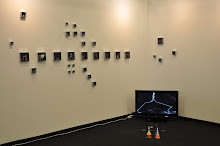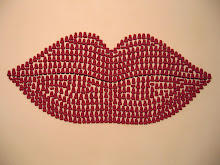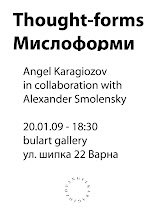
GOLDEN PAINTINGS.PROJECT BY PETER MINTCHEV.BULART GALLERY
26 March - 10 April 2010
VARNA.22 SHIPKA STR.
“Peter Mintchev’s ‘Golden Paintings’”- Rebecca Lane, art critic
Sometimes it can be difficult to remember that allegory can be not only deeply evocative, but also poignant, light-hearted and cleverly subversive. Recent art and literary criticism have often made it a heavy, antique concept, but in Peter Mintchev’s current “Golden Paintings” exhibition, it is deployed both conceptually and materially with a determined yet playful touch. Each of the exhibition’s works is a multi-layered stratification of visual meaning, potently buzzing with a luxurious golden shimmer that fluctuates between surface and base of the paintings. “Calendar” and its companion piece “The Moon” use exaggerated scale and near monochrome surfaces to turn realism on its head, rendering it simultaneously abstract and conceptually melancholic. The former painting’s desk calendar could be taken as a totem object of great material significance, set against a backdrop of a richly hued plane; but it alternately could be seen as a dwarfed world set adrift atop a beautiful, but menacing substance, not unlike the bright red-orange coal runoff found in highly polluted industrial waterways. “The Moon” presents its subject at times as a luminous pearl cushioned against a velvety night sky, but then shifts with the viewer’s perspective and available light to engulf the small sphere in its inky blackness, rendering the moon as both distantly mystical and tenuously miniscule. A similar disorientation is provoked by the overwhelming surface of “Nettles” whose realism and lush painted depth seduce the viewer’s gaze to venture deep into the plants’ midst despite their well-known unwelcoming sting.
Mintchev’s surface allegories step confidently from modernist abstraction and melancholy to playful subversion of established tropes of realist painting, whether it be the presence of the artist’s hand which he unabashedly sends up in “Finger”, or his cheeky reverence for the shimmer and texture of the humble still-life forms of “Onions and Lemons”. More complicated, perhaps, but no less provocative is his approach to the genre of pendant marriage portraits. “Husband” and “Wife”, like the other paintings in the series, relies upon photography for its source imagery, but it is in these images where the presence of the camera feels most apparent and most in conversation with the medium of painting that Mintchev confronts so persistently in this series. These marriage portraits have not been posed, but instead retain the fleeting quality of snapshots. Yet when coupled with his gold goache underpainting and surface scraping technique, Mintchev achieves a poignant tension between the power of the painted image to immortalize and enshrine that which it objectifies and the intangible emotional pulse that render romantic love immaterial.
The allegory of gold itself runs strong throughout this series, but as with the other allegories present, it does so in a manner which takes the medium far beyond its usual associations, but while toying with them all the same. Unlike Damian Hirst’s recent foray into gold’s literal cynicism, leading the viewer nowhere but to shameless vulgarity, Peter Mintchev’s “Golden Paintings” demonstrate the alchemical potential of rich materiality to give its subjects a weightless conceptual depth /1/.
------------
1-See the current exhibition, Damian Hirst, “End of an Era,” January 30-March 6, 2010, Gagosian Gallery, New York.
* Rebecca Lane is an art historian and critic from the West Coast of the United States. She has studied in Minnesota, New York state and Vancouver, Canada. Rebecca's areas of specialty are American Art after 1945 and Contemporary Art, Politics and Institutions. Since summer of 2009 she lives and works in Bulgaria.































































![exi[s]t bulart ebook](https://blogger.googleusercontent.com/img/b/R29vZ2xl/AVvXsEioLWi9Bq5hmFvUu0ImT64grqtpQjixKm9wiCNQkQ6AdAlEa5aq1iLfsTGEq1GV3GQb2MbSj4GSE7U1iEClWSGR3D32F3VkznqUXKqGMCsuJntehbQY8qQHGCgpaxWg-0FcmiUitYSCQMCh/s220/15_b.jpg)






















![exi[s]t > 15 bulart](https://blogger.googleusercontent.com/img/b/R29vZ2xl/AVvXsEj37ypbsysl9JGNfwu_CO9UoE1SxOZwESzhdFy-EpB-j-iNzzCg7TUGTTkwLpjJVtYtE0eSZdWw6dTG32xGxUraJUUsCzUXoZtdLisSTJXwMhbCWA3maUS8aNVYEXkartg_4fWo43BJhTr7/s220/P8250003.jpg)
![exi[s]t > 15 bulart](https://blogger.googleusercontent.com/img/b/R29vZ2xl/AVvXsEhDEeE5wxYmDxuOXYbh1FO0MQhwHWdBNg9-3DINFK1LG6PGUVvt-Lasm7yh7sc_90EAIXulz0Wgj_CHQJhnZSJ7L6EKvuyfp3kw9xGYxKtEjGuey_vDciyWZQ1V-RQzzZyykk4xP296c5W_/s220/P8250120.jpg)
![exi[s]t > 15 bulart](https://blogger.googleusercontent.com/img/b/R29vZ2xl/AVvXsEi5Wf0uYquCA73UPStwUDx93SFypnpSwE4_1__dqzuHp82faO6EgkszFDMSnay-mmDfD8eJhhHUROLJeymm7njWsV2OcZzMbhDIVmEPi5Iv8hdmK4HpwGaV0GE2NLdc8VrQKWD5uRt4qIoc/s220/P8250139.JPG)
![exi[s]t > 15 bulart](https://blogger.googleusercontent.com/img/b/R29vZ2xl/AVvXsEhvk1ulNExDHDKjdRClHOZtqV7Z6jyiQlvw4YceTb_lSF97SKF4rc80v8Ju8seSoGyG3ohgYMjMWfZiVY57oUfc4W6Vlnql_HaSzpw3go0uwIiHIEYpBPEUE2IHBshHELc3gHxpDCYq4hnP/s220/P8250027.jpg)
![exi[s]t >15 bulart](https://blogger.googleusercontent.com/img/b/R29vZ2xl/AVvXsEgvH1ixGS_12SHVi4VdeB_fvNX5NHZ-Hh0Aj_RBGBVh13ODqZZ_Pw2MXYkebw3UDR81K4tSuhHWABEdF725-Xk8V-gKWnZ9IVWteDZnLBZxVu9w9lNvtx-xdiPlnSd_8YG0Sl8A3yAH5r_v/s220/IMG_0447_resize.JPG)
![exi[s]t > 15 bulart](https://blogger.googleusercontent.com/img/b/R29vZ2xl/AVvXsEgvaMZtabJW0YLZLAQw_GlET40MsxF_wbjtNb6O4E9qGz3tTp28jn4reYOqXvXjOLxb56LO6-NZPFT-y3dThzTjDeqxD-mMPd9y55R9PdUp8ug3ZTQkovi7C7S6EBHwdaMkNYkjCM3bBBP8/s150/P8250133.jpg)
![exi[s]t > 15 bulart](https://blogger.googleusercontent.com/img/b/R29vZ2xl/AVvXsEh28eEzpo7Rd4U7-TE6AdNoja2D3YoGXtNOCLzSAUM7ivsjYlosKoyatOm_Qab3tI8ZgH4ZiRgOqXkh5V7GZN8Evc_exfxSNF0afXCueCjiPPGGzBRhbkK6UrLRgt6Bdd-Y22A6EojZe7yj/s220/PA100023.jpg)
![exi[s]t>15bulart](https://blogger.googleusercontent.com/img/b/R29vZ2xl/AVvXsEjUcBi0QOmlgVAXEt8oo75rgupd5Sbv2dacLaaVzj1KG4k487X-e8vor51vUbCPu2XF4x5MDVUqVHhwLFCsyVfklmY012jLL35O6digJhWoNL5i1SBTiw052l6x4c7SOcXC51eLf4-dm-WW/s220/NENO+Sequence+01+kadyr+video+%25282%2529.jpg)
![exi[s]t >15 bulart](https://blogger.googleusercontent.com/img/b/R29vZ2xl/AVvXsEgO_L3KuolDJTltY0BlgOiag1fdvjWYO__yISlVHYHYd2H2uhW3ubfngBC995fxM5bccbwIHC59KUA3URT8TRdanBVy-fqO7mF6vSWLn36NGfDkdIfx9r_V0CNHDWw45qcbfgf9r3gAjDK_/s220/P8250039.jpg)
![exi[s]t >15 bulart](https://blogger.googleusercontent.com/img/b/R29vZ2xl/AVvXsEhglP-fpLBIO7zxHHJOGBFML3H1u6B9fxe3R8xdOyNvHcU4dk2oY1r4Fyiez1e1TsISsvGjjKr1oBz9zTPnbe9xh0ZQyvgU90Q51iFi0Lib2AwOIS2-gmfj6yavzWj6TTax4XEFWYSHKssr/s220/IMG_0446_resize.JPG)
![exi[s]t >15 bulart](https://blogger.googleusercontent.com/img/b/R29vZ2xl/AVvXsEjljyaHP4gPoQTBnbXm7PrpwUv9fRd2l2knAsF_Xav5pDnNHqbxnOP3ZtmKv6doDFrvSRr8ZXWhlTQxxIqO23bP4ZtviZFju1ZsZOJzcqPGdekWIfjCMjj9CBaGvFNuwsLXXpcJSGFj2rX3/s220/blindfold_alessandra+arno.jpg)
![exi[s]t >15 bulart](https://blogger.googleusercontent.com/img/b/R29vZ2xl/AVvXsEiTzPZsdXzlnjfw7JaIwtIHxsi2xxzRXAuQs-6Ghyphenhyphen43qW48VI-_t6zDbV82rpss_i4yA-gfEYjcDWwxW5Jn7rTTLT0TVhssegfIry50iBkPWZy5JGPHiLrLY47GO3aajs-HgscMPbG6pgvo/s220/P8250078.jpg)
![exi[s]t > 15 bulart](https://blogger.googleusercontent.com/img/b/R29vZ2xl/AVvXsEhGrCZq5f46aa7FwCxu3AcYjksQ78Dd3y0IvbAAu29s1loarEJO-2zY-Q3b6YCanZr0863S95MLW_29wBnhL0iptDaPgu7IJJ89Vfqd3VNwIlgBhWs2qQaA0oOAvhPlUvzAzVOkiLGAX67K/s220/The+Yellow+Serpent+by+Stephan+Halter.jpg)
![exi[s]t > 15 bulart](https://blogger.googleusercontent.com/img/b/R29vZ2xl/AVvXsEhm1-q0yPFYu1lj1Aiw_AI3Rll0nVmuFTA1FaimhVFvirrpZbUjzZAoVv-NwXOxUTrK4aHqhhHUXScBecdkdAGfcwiAcPEICtkTQkI_t9RVZrtjhWAfOsxmvb2MVOZRV0s0HSF0r6zrJo8r/s220/IMG_0333_resize.jpg)
![exi[s]t >15 bulart](https://blogger.googleusercontent.com/img/b/R29vZ2xl/AVvXsEiodFdimjAYsbw_mNoXFA2777EJsbBNC4qixUE7J0zxeXcMMefJsipGw8rCdMOQ5wR1B1-Zmb8yqQJ6x_jgSnbIB4JCfJsjR7qLckmSYT-Csyi-Gy4TdNXJ-Abo2Hp2plMqekI_UY61Z1Zd/s220/kostolov_me4tatel.jpg)
![exi[s]t >15 bulart](https://blogger.googleusercontent.com/img/b/R29vZ2xl/AVvXsEhqAu2tgN1HQxpCY6DyDxFL2XyBXjnRoRSK_x4WCZfreF1fy8LjHGVrhu3oAOmzZZFnA3LLBJ6YVrkNLG55m53AOrCrwHB63tFNSh62BuVJuj6cvRqu-ii5AIB9WpmizQAudilkRH4lWH9r/s220/04.welcome+with+tv.jpg)
![exi[s]t >15 bulart](https://blogger.googleusercontent.com/img/b/R29vZ2xl/AVvXsEgI4fsND39j1baVLdxWxBidONUCjodHqFsqgQRDbmktS6sXjH3IoZpbfCIqD8IHIzY8yQGjp_ESVRNcO_fM31f0sBkEcSQXiQ71f34z2Psv_tHjjBwiLpcL21Mgp035H5ye_B2BPHNDrN4O/s220/IMG_0307_resize.JPG)
![exi[s]t >15 bulart](https://blogger.googleusercontent.com/img/b/R29vZ2xl/AVvXsEg3CgpArmMGsQjnB-BzWV-UahWel8gIswHdafgxuHjJRGAg3sh7n6kCvLOw-YwR_ZjzjFawsHLSvUPdWHViYJLSF5jChi5Yi1Y0Rlf4CB8U5gjamnKBqhrLI-2AEyFphPS_RzEaBfAzHUDp/s150/40310.jpg)
![exi[s]t >15 bulart](https://blogger.googleusercontent.com/img/b/R29vZ2xl/AVvXsEj5CIJQk4TUFfYtdBsTfFut1wz7g4gyXB1H0_dk_w1HXeIIkv00yZgmcR5ybq2qcuPVlO0hKZnrjcOXEPvnC6sQnJolgXrC5u0fSHmLl8XcPF6fM-gz-NYL5Hg8WZYRit4P7ZwXTkS-wSOR/s220/buffet.jpg)




























































No comments:
Post a Comment